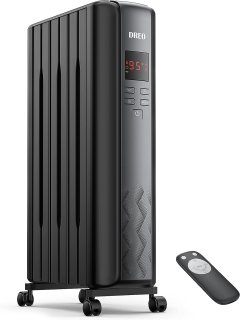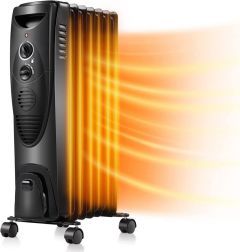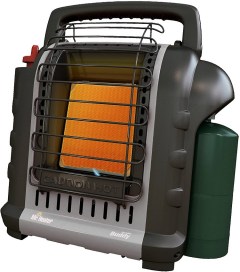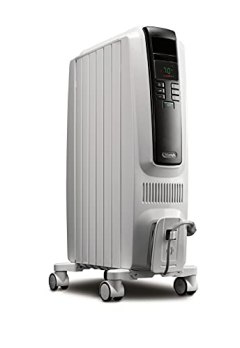
This electric space heater offers 1,500-watt power output and sufficiently heats a 300-square-foot room.
This electric space heater offers 1,500-watt power output and sufficiently heats a 300-square-foot room.
This oil-filled heater has spindle-shaped openings and M-shaped heating fins, creating a stack effect to provide 360-degree air circulation. It has a cool-touch design to prevent accidental burns and a smart function that adjusts settings based on a room's current temperature.
There are rare reports of occasional oil leaking.

A portable oil-filled heater with wheels for easy maneuvering that's great for small spaces.
A portable oil-filled heater with wheels for easy maneuvering that's great for small spaces.
This electric space heater has three thermostat modes and a power indicator light that lets you know when it's plugged in. It has a sleek design, operates quietly, and has an emergency switch that automatically shuts it off when tipped forward or backward. Features built-in cord storage.
The power indicator light stays on at all times, even if its plugged in and not running.

A versatile electric space heater that can be easily transported and placed anywhere or mounted on a wall.
A versatile electric space heater that can be easily transported and placed anywhere or mounted on a wall.
This radiant heater is excellent for garage and patio use and has a built-in safety feature that automatically shuts it off if it's tipped over. It has an IP55 protection rating for withstanding the elements, three heat modes, and a built-in timer. It comes with mounting hardware and a remote control.
The central unit doesn't have a power switch, so it can only be operated using the remote control.

An easy-to-use, effective propane radiant heater that can heat a relatively large area of your home.
An easy-to-use, effective propane radiant heater that can heat a relatively large area of your home.
Can heat a room up to 225 square feet. Handle makes it easy to move from place to place. Durable build. Two color options: red and gray. Two auto-shutoff functions give peace of mind. Has 2 heat settings: 4,000 or 9,000 BTUs. Can be used in tents and other sheltered outdoor spaces, as well as indoors.
A few reports of faulty units and lack of customer support.

Large and powerful heater for those in need of extra warmth in roomy spaces.
Large and powerful heater for those in need of extra warmth in roomy spaces.
Durably made, sizeable heater with 1500 watts of power to heat up small rooms. Operates quickly and efficiently. Includes antifreeze setting. Auto shutoff. The wheeled design allows for easy movement. The LED display is easy to read and comprehend. The wider wheel set makes it less prone to tipping.
Large, bulky, and expensive.

We recommend these products based on an intensive research process that's designed to cut through the noise and find the top products in this space. Guided by experts, we spend hours looking into the factors that matter, to bring you these selections.

If you live in a cold climate or just have a drafty home, staying warm can be difficult, even with a central heating system in place. A space heater can definitely help, though, and a radiant heater is one of the most effective space heater options out there.
Unlike a traditional convection heater that circulates warm air through an entire room, a radiant heater passes heat directly to the people and items in the room. This allows the space around you to heat up more quickly and evenly. Radiant heaters work especially well for rooms in which you don’t move around much, like a bedroom. Because radiant heaters don’t blow dust and dander around, they’re a great for choice people with allergies.
When looking for a radiant heater, you’ll have some important decisions to make. Should you get a portable or stationary heater? A large model or several small ones?

Most radiant heaters are portable, so you can easily move your heat source from one spot to another. However, some are permanent fixtures that you install in a wall or ceiling. A permanent installation may be more appropriate if you only have one area of your home you want to heat. For most people, however, the versatility of a portable heater is more appealing.
Portable radiant heaters tend to be less expensive than permanent installations. And, if you’re a renter, you don’t have to deal with the hassle of asking permission to drill holes in your wall or ceiling.
Most radiant heaters intended for indoor use are powered by electricity. A power cord plugs into a standard wall outlet, allowing you to place the heater anywhere in that vicinity. However, you can also find gas-powered radiant heaters. Some models use propane; these work well for outdoor use, such as on a patio. A propane radiant heater is also a good choice if you’re looking for a way to heat an outdoor worksite.
Other gas-powered radiant heaters run on natural gas, though certain models are only permitted for outdoor use in some states and counties in the U.S. You must have a gas line at your home to connect the heater, so installation must be done by a qualified technician.
Heater size matters: you want something large enough to heat the desired area but not so large that it significantly drives up your electricity bill. To determine the heating radius of a radiant heater, consider its wattage. For the most effective heating, you’ll need approximately 10 watts per square foot of space. Here are some general guidelines.
Keep in mind that using a radiant heater as a supplemental heating source to your main HVAC system usually allows it to heat a larger area.

Some radiant heaters have simple button or dial controls. These are easy to use but don’t offer as much precision as a heater with digital controls. If you opt for a digitally controlled heater, look for one with a clear, easy-to-read LCD display. The display should tell you the current temperature, your chosen heat setting, and any particular heating modes that are in use.
Digitally controlled radiant heaters usually feature an adjustable thermostat as well. This allows you to choose a specific temperature for the heater. This feature affords you great control over how warm your space becomes, so it can be extremely handy for keeping energy costs down and your home as comfortable as possible.
Most radiant heaters offer at least two heat settings with different wattages, such as “high” and “low.” For example, a low setting may operate at 900 watts, while a high setting may operate at 1500 watts. Even models with an adjustable thermostat have multiple heat settings for when you want to heat your room quickly and easily.
Some radiant heaters have an economy mode that automatically shuts the heater off when it reaches a specific temperature. If the temperature begins to drop, the heater turns back on.
If you want your home to be warm as soon as you get home from work or school, choose a radiant heater with a timer. You can program the times at which the heater will turn on and off, so it’s always working exactly as you want it to. Most timers can be set to run for a span of nine to 12 hours.
As with any space heater, it’s important to choose a radiant heater with safety features that give you peace of mind. Safety features to look for include the following.
A cool-touch exterior helps keep the outside of the heater cool so you don’t have to worry about children or pets coming into contact with it.
A tip-over switch automatically cuts the power to the heater if it tips over.
If portability is a priority, pay attention to any features that would make a radiant heater easier to move. Some heaters have wheels or casters that allow you to roll it from room to room. Others have handles that make picking the heater up and carrying it to another spot easier.
Want to adjust your radiant heater settings without getting off the sofa? Many radiant heaters come with a remote control for this very purpose. Most remotes have controls for all heater features, so you can change the heat setting, adjust the temperature, or set the timer without having to get up.
You could buy a radiant heater for as little as $15 or as much as $475, depending on what features and wattage you want.
Radiant heaters of 900 watts or less are designed to heat small spaces. These heaters have few special features, and the price reflects that. You can buy an entry-level radiant heater for $15 to $60.
Radiant heaters in this range can heat slightly larger spaces, and their wattage varies from 900 all the way up to 1,500. Priced from $60 to about $250, these products may have special features, such as digital controls or a timer. As you might expect, the more you pay, the more wattage and features you’re likely to get.
The most expensive radiant heaters can heat large spaces. Wattage is 1,500 at minimum and may be more. Expect to pay between $250 and $475 for a heater like this, and expect a bevy of great features to accompany your purchase: digital controls, timer, adjustable thermostat, and more.

Keep all flammable materials, including furniture, bedding, and curtains, three feet or more from your radiant heater.
For efficiency, position your radiant heater so it’s approximately one to two feet from the wall to prevent the wall from absorbing the heat that it emits.
Closing the door to a room where you place a radiant heater can help trap the heat so the space heats up faster and stays warm longer.

Q. Is a radiant heater an energy-efficient choice?
A. If you’re going to be sitting close to it, yes. A radiant heater warms you and the objects around you directly rather than working hard to heat up the entire space. Radiant heaters work especially well in small spaces because you can easily position yourself to be directly in line with the heater.
Q. How noisy is a radiant heater?
A. Radiant heaters are extremely quiet. In fact, most don’t make any noise at all. They’re able to work silently because they don’t have a fan that forces the warm air throughout the space like other space heaters do.
Get emails you’ll love.
Learn about the products you’re wondering if you should buy and get advice on using your latest purchases.
